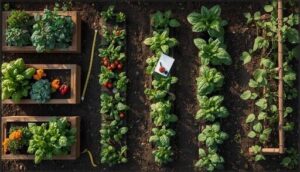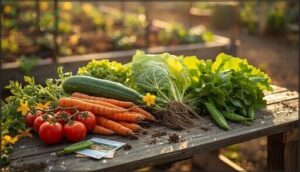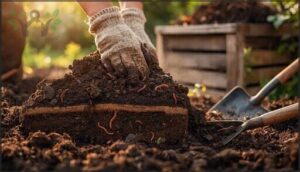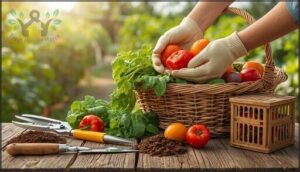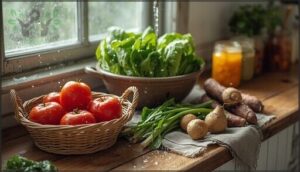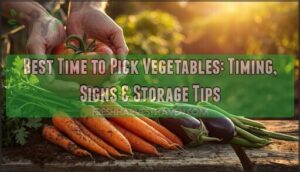This site is supported by our readers. We may earn a commission, at no cost to you, if you purchase through links.
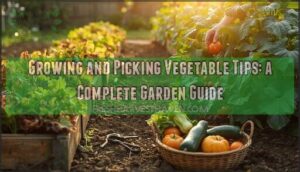
A garden that produces crisp lettuce in May, ripe tomatoes in July, and winter squash in October doesn’t happen by accident—it’s the result of deliberate choices made months before the first harvest. Most beginning gardeners focus on planting day, but the difference between a modest yield and baskets of fresh produce lies in the decisions you make about location, soil preparation, and timing.
Sunlight exposure, drainage patterns, and companion planting arrangements determine whether your plants struggle or thrive.
The techniques for growing and picking vegetable tips covered here address each stage of the process, from selecting a site that receives adequate light to harvesting at the precise moment when flavor and nutrition peak, giving you the knowledge to transform your garden space into a reliable source of fresh vegetables.
Table Of Contents
- Key Takeaways
- Choosing The Best Location for Vegetables
- Planning Your Vegetable Garden Layout
- Selecting Easy-to-Grow Vegetables
- Preparing Soil for Healthy Growth
- Essential Vegetable Garden Maintenance Tips
- Harvesting Vegetables at Peak Freshness
- Storing and Handling Freshly Picked Produce
- Frequently Asked Questions (FAQs)
- Conclusion
Key Takeaways
- Your garden’s success depends on three foundation decisions made before planting: choosing a site with 6-8 hours of direct sunlight, ensuring soil pH between 6.0-7.5 with proper drainage, and installing windbreaks that can boost moisture retention by 20% while cutting wind speeds by half.
- Starting with a manageable 100-square-foot plot and easy crops like beans, lettuce, and radishes builds confidence through forgiveness of beginner mistakes, while succession planting every 7-14 days can increase total yields by 30-60% compared to single plantings.
- Harvest timing transforms produce quality—picking in early morning hours (before 10 a.m.) locks in 20% more moisture and preserves 18-25% more vitamin C in leafy greens, while waiting for proper maturity signs like color change and texture tests ensures peak flavor.
- Soil preparation through regular compost additions (increasing organic matter from 7.37% to 8.33%) combined with 2-3 inches of mulch cuts watering needs by two-thirds while blocking weeds, creating the foundation for healthy growth without constant intervention.
Choosing The Best Location for Vegetables
Your vegetable garden’s success starts with the spot you choose. The right location gives your plants what they need to thrive, while the wrong one creates problems you’ll fight all season long.
Let’s look at the three essentials that’ll make or break your garden before you plant a single seed.
Sunlight and Shade Requirements
Before breaking ground, you’ll want to assess your sunlight hours—most vegetables need six to eight hours of direct light daily for healthy photosynthesis. Leafy greens show decent shade tolerance with just two to three hours, but fruiting crops like tomatoes demand closer to eight.
Light quality matters too; full sun drives maximum growth rates, making sunlight duration a cornerstone of any solid garden plan. Understanding shade gardening basics is essential for optimizing vegetable growth in various sunlight conditions.
Soil Quality and Drainage
Once you’ve mapped your light, turn your attention to what’s underfoot. Soil testing reveals pH levels—most vegetables thrive between 6.0 and 7.5—while drainage systems prevent waterlogging that can slash yields by 33%. Check your water table depth and boost organic matter to 6% or higher; regenerative practices build soil health that translates directly into better harvests.
Consider these soil preparation fundamentals:
- Test pH before planting—asparagus tolerates 6.0–8.0, but potatoes prefer 4.8–6.3
- Improve drainage to avoid oxygen deficiency that reduces photosynthesis
- Add compost to increase water-holding capacity and prevent soil erosion
- Build soil structure through aggregation, creating pore space for root development
- Monitor soil conditions seasonally, adjusting soil management as crops rotate
Understanding soil pH levels is vital for ideal plant growth.
Good gardening basics start below ground, where soil preparation sets the stage for everything above.
Wind Protection and Water Access
Your drainage work lays the groundwork for the next layer: wind barriers and irrigation management. Windbreaks cut wind speeds by 50–75%, reducing soil erosion and boosting moisture retention by 20%. Rye strips prevent up to 30% yield loss from sandblasting while creating a warmer microclimate.
Pair these sustainable gardening practices with drip irrigation systems reaching 90% efficiency, and you’ll master water conservation fundamentals that make garden design and layout truly productive.
Planning Your Vegetable Garden Layout
A thoughtful layout turns a collection of plants into a productive system that works with your schedule and space. You’ll need to decide how much ground you can realistically manage, whether to build up or plant down, and which vegetables actually help each other thrive.
These three decisions shape everything from your daily watering routine to your end-of-season harvest.
Selecting a Manageable Garden Size
Starting a garden means matching ambition with reality. A 100 square foot plot (10×10 feet) gives beginners breathing room to learn without overwhelming maintenance demands.
If you’re short on time or space, a 4×8 foot bed works beautifully—small enough to manage with hand tools, yet productive enough to yield meaningful harvests. Your garden plan should fit your schedule, not stretch it thin.
Raised Beds Vs. In-Ground Plots
Your garden plan starts with a choice: raised beds or in-ground plots. Raised garden bed construction costs $15-50 per square foot but delivers enhanced drainage systems and soil comparison advantages—warming faster in spring and producing 20-30% higher yields through space efficiency.
In-ground vegetable gardening offers flexibility and lower costs, though you’ll work harder managing native soil conditions.
Bed construction simplifies crop rotation and garden design over time.
Companion Planting Strategies
Strategic companion planting transforms your garden plan into a high-functioning ecosystem. Polyculture benefits include 32% higher yields while slashing pest control needs through crop diversity. Your vegetable gardening success increases when you:
- Pair nitrogen-fixing legumes with heavy feeders for soil enrichment
- Use aromatic herbs like basil to repel harmful insects naturally
- Alternate root depths to reduce nutrient competition
- Plant tall crops to create microclimate management for shade-lovers
Selecting Easy-to-Grow Vegetables
Choosing the right vegetables can make or break your first gardening experience. You’ll want to focus on plants that forgive beginner mistakes while still delivering a satisfying harvest.
Let’s look at which vegetables will set you up for success, how your local climate shapes your options, and whether heirloom or hybrid varieties make the most sense for your garden.
Best Starter Vegetables for Beginners
You’ll want to start with vegetables that build confidence rather than test your patience. Beans, lettuce, peas, radishes, and summer squash consistently rank as gardening for beginners favorites—these crops tolerate beginner mistakes while producing reliable yields.
Companion planting these vegetables with herbs improves pest resistance by up to 20%.
Choose garden seeds suited to direct sowing, and invest in basic garden tools for gentle care that encourages strong growth.
Climate and Growing Season Considerations
Your frost dates and temperature ranges determine which vegetables will thrive—not just survive—in your garden. Zone 5 gardens usually enjoy 100–120 frost-free days, while zone 10 stretches beyond 300 days annually.
Climate shift has extended U.S. growing seasons by 10–20 days over the past half-century. Match your crop choices to your season length, and weather patterns become your ally in sustainable gardening success.
Heirloom Vs. Hybrid Varieties
Breeding methods shape everything from flavor to your future seed costs. Heirlooms offer genetic diversity and enhanced nutrient content—you can save seeds year after year. Hybrids deliver consistent crop yields and disease resistance but require annual purchases.
Here’s what matters for vegetable garden planning:
- Seed saving works only with open-pollinated heirloom varieties
- Hybrids excel in predictable harvests and pest tolerance
- Heirlooms shine in organic gardening for their complex flavors
Preparing Soil for Healthy Growth
Your soil is the foundation of everything your plants will become. Without nutrient-rich earth and proper structure, even the easiest vegetables will struggle to thrive.
Let’s look at two key ways to build and protect healthy soil from the ground up.
Composting and Organic Matter
Think of compost as your garden’s secret weapon—it transforms ordinary soil into a thriving ecosystem. When you add organic matter regularly, you’ll notice improved soil structure, better water retention, and enhanced nutrient cycling. Compost benefits extend beyond plant growth; it aids carbon sequestration and reduces your reliance on synthetic organic fertilizers, making organic gardening methods both sustainable and effective for vegetable gardening success.
Research shows organically managed soils average 8.33% organic matter compared to 7.37% in conventional systems—that difference translates directly to healthier crops. When you apply compost, you’re not just feeding plants; you’re cultivating billions of beneficial microorganisms that power nutrient cycling. Surface applications reduce soil erosion and keep your produce cleaner by minimizing splash during rain. For organic farming enthusiasts, compost offers a pH near 6-7, perfect for most vegetables, while sequestering over 522,000 tons of CO2 equivalents annually across US gardens.
| Compost Material | Key Nutrients | Best For |
|---|---|---|
| Kitchen scraps | Balanced NPK | General soil enrichment |
| Chicken manure | High nitrogen (2%) | Leafy vegetables |
| Yard waste | Moderate nutrients | Building soil structure |
| Aged leaf mold | Stable organic matter | Water retention |
| Mixed compost | 2% N, 0.5-1% P, 2% K | All-purpose gardening for beginners guide |
Mulching for Moisture and Weed Control
After enriching your soil with compost, layering 2-3 inches of organic mulching materials locks in that moisture and blocks weeds before they start. Straw, shredded leaves, or grass clippings work beautifully for vegetable gardening—they regulate soil temperature while cutting watering needs by up to two-thirds.
This simple garden maintenance and care step transforms your gardening for beginners guide into a practical garden planner you’ll rely on all season.
Essential Vegetable Garden Maintenance Tips
Once your garden is planted, the real work begins—but don’t worry, it’s the kind of work that pays off with every ripe tomato and crisp lettuce leaf. Consistent care makes the difference between a struggling patch and a thriving vegetable garden.
Let’s walk through the essential maintenance tasks that’ll keep your plants healthy and productive all season long.
Watering and Fertilization Schedules
Consistently, your garden’s performance hinges on smart water conservation and fertilizer timing—two elements that work together to boost yields. Here’s how to master both aspects of garden maintenance and care:
- Provide 1 to 2 inches of water weekly, adjusting for soil moisture levels and rainfall.
- Water sandy soils twice weekly with about 31 gallons per 100 square feet.
- Apply nitrogen fertilizer every 3 to 4 weeks during the growing season.
- Use drip irrigation systems to save up to 60% water compared to traditional methods.
- Balance nutrient inputs—excess nitrogen delays fruiting while proper crop management ensures steady production.
Deep watering every two days in summer can boost tomato yields by 15%, while root vegetables like carrots perform 25% better with weekly deep watering. Morning watering in spring promotes 20% better growth, and adjusting your garden planner for fall reduces water use by 30% without sacrificing results.
Your vegetable gardening success depends on this irrigation-fertilization synergy, as studies confirm these factors interact strongly to affect fruit yield and water use efficiency. Remember that nitrogen promotes leafy growth, phosphorus aids roots, and potassium strengthens disease resistance—achieving nutrient balance is essential for thriving crops.
Weeding and Pest Management
While proper watering feeds your plants, weed control and pest management protect what you’ve built. Nearly half of gardeners want to spend less time weeding—and you can with smart strategies. Here’s your action plan:
| Challenge | Organic Methods | Timing & Tips |
|---|---|---|
| Early weeds | Light hoeing between rows | Remove before flowering |
| Persistent weeds | Mulch layers + spot vinegar treatments | Apply during seedling stage |
| Cabbage loopers | Prune damaged leaves, encourage predators | Monitor every 3-6 weeks |
| Thrips damage | Organic sprays from biological sources | Daily observation critical |
Integrated systems combining mulching, crop rotation, and mechanical removal build soil health while reducing chemical reliance—giving you healthier vegetables with less effort.
Staggered Planting for Continuous Harvest
Beyond managing pests, succession planning transforms your garden’s productivity. Staggered planting at 7–14 day intervals keeps vegetables flowing from spring through fall—lettuce and radishes especially thrive with this approach.
Your harvest scheduling strategy should include:
- Plant quick-maturing crops like beans every two weeks
- Track planting dates to adjust future intervals
- Rotate crops between rounds to disrupt pest cycles
Smart gardening tips boost yields 30–60% over single plantings.
Harvesting Vegetables at Peak Freshness
Knowing when and how to harvest your vegetables makes all the difference between bland produce and something truly delicious. The timing, technique, and even the hour you pick can dramatically affect flavor, texture, and how long your harvest stays fresh.
Harvest timing, technique, and even the hour you pick dramatically shape your vegetables’ flavor, texture, and freshness
Let’s look at the key factors that’ll help you bring in vegetables at their absolute best.
Signs Vegetables Are Ready to Pick
Knowing when your vegetables hit peak maturity transforms your harvest from guesswork into precision. Color indicators offer the most obvious maturity signs—tomatoes shifting from green to deep red, peppers changing hues, or watermelon ground spots turning creamy yellow. Texture tests matter too: snap beans should break cleanly, while cucumbers feel firm at 6–8 inches for slicing types.
For proper harvesting, don’t overlook sugar levels—cantaloupes need 13% Brix for ideal sweetness. Harvest timing depends on variety: radishes mature in 30 days, tomatoes in 120. Watch lettuce closely before bolting begins, and remember potatoes signal readiness when half the plant tops collapse and dry.
| Vegetable | Key Harvest Sign |
|---|---|
| Broccoli | 4–7 inch heads, tight buds |
| Eggplant | Glossy skin, 4–5 inches wide |
| Okra | 2–3 inches long, tender pods |
Best Time of Day to Harvest
Timing your harvest for early morning hours—between sunrise and 10 a.m.—locks in up to 20% more moisture content and preserves peak freshness. During this window, your vegetables retain higher sugar levels and maintain firmer texture due to cooler temperatures.
Morning harvest schedules also protect vitamin C content in leafy greens, boosting nutrient retention by 18–25% compared to daytime picking sessions.
Tools and Techniques for Gentle Harvesting
Your choice of harvesting tools determines whether produce arrives at your kitchen undamaged or bruised. Sharp, sanitized blades cut microbial contamination by 40%, while ergonomic designs reduce fatigue by 27% during extended picking sessions.
- Scissor-action pruners for delicate stems and leafy crops
- Clean, sharp knives for precise vegetable removal
- Perforated harvesting bins to accelerate cooling
- Broadforks for gentle root vegetable extraction
- Twist-and-snap technique for fruiting crops like peppers
Storing and Handling Freshly Picked Produce
Once you’ve harvested your vegetables at their peak, how you handle them in the next few hours makes all the difference. The way you clean, store, and care for your produce directly affects its flavor, texture, and nutritional value.
Let’s walk through the essential steps to keep your garden-fresh vegetables in top condition.
Cleaning and Prepping Vegetables
Your harvest’s true test begins once you bring it inside. Start by rinsing produce under running water for at least 20 seconds—this simple act removes surface dirt and cuts microbial loads substantially.
For deeper food safety, vinegar washing (a 5% solution for three minutes) delivers roughly 90% microbial removal, outperforming soap and boosting heavy metal reduction by about 50% on leafy greens.
Short-Term Storage Methods
Your refrigerator is the workhorse of PostHarvest Handling—store most vegetables at 4°C to slow spoilage by up to 60% and extend Shelf Life Extension by five days. Effective Temperature Management and Humidity Control make all the difference:
- Set crisper drawers to 90-95% humidity for leafy greens, boosting freshness 40-50%
- Use airtight Packaging Options to lock in moisture and delay wilting 2-4 days
- Keep root crops like onions in cool pantries at lower humidity (60-70%)
- Remove tight wraps at room temperature to prevent trapped moisture and decay
These Refrigeration Tips anchor smart Fresh Produce Handling after Harvesting and Storage.
Tips for Maintaining Flavor and Nutrition
Want Vitamin Retention and Flavor Enhancement at their peak? Cut vegetables right before serving—delaying prep preserves 30-70% more nutrients through smart Postharvest Handling.
Your Freshness Maintenance strategy should include immediate cooling after Vegetable Harvesting, maintaining 85-95% humidity for ideal Nutrient Preservation, and using acidulated water to prevent browning.
These PostHarvest Handling techniques transform Fresh Produce Handling into a science, keeping Vegetable Storage simple yet effective.
Frequently Asked Questions (FAQs)
How do I deal with unexpected frost damage?
It’s odd how frost always seems to strike just when you let your guard down. Act fast: cover cold-hardy crops, water soil for insulation, and rely on these classic winter care tactics to boost climate resilience and prevent freeze damage.
Can I regrow vegetables from kitchen scraps?
You can regrow green onions, celery, and lettuce from scraps placed in water, achieving success rates above 75%. This scrap reuse cuts grocery bills by 5-7% and aids kitchen composting goals.
What are common nutrient deficiency signs in plants?
Nitrogen deficiency shows as yellowing older leaves, while phosphorus shortage causes purpling. Low potassium levels produce brown leaf edges, and magnesium deficit creates interveinal chlorosis.
Micronutrient imbalance often appears as mottled patterns—all critical gardening tips.
How do I save seeds for next season?
Seed selection begins with open-pollinated varieties—hybrids won’t reliably reproduce.
Harvest timing matters: wait for full seed maturity, then dry seeds thoroughly below 8% moisture.
Store in cool, dark conditions under 10°C to preserve viability for years.
When should I rotate crops to prevent disease?
You should rotate crops every three to four years to break disease cycles effectively.
Spacing crops by family—like avoiding planting tomatoes after peppers—reduces soil-borne pathogens and maintains soil health.
Conclusion
Think of your garden as a living clock—each planting decision sets the hands in motion toward harvest. The growing and picking vegetable tips you’ve learned here give you the precision to synchronize sunlight, soil preparation, and timing into reliable yields.
When you select the right location, prepare beds properly, and harvest at peak ripeness, you’re not just growing food—you’re cultivating expertise that deepens with every season, transforming uncertainty into consistent abundance.
- https://raleighrealty.com/blog/gardening-statistics-trends
- https://petruslandscape.com/gardening-statistics-in-2025/
- https://www.greenprofit.com/Article/?articleid=27264
- https://www.ramseymastergardeners.org/post/home-garden-productivity-study-results
- https://ers.usda.gov/sites/default/files/_laserfiche/outlooks/111478/VGS-375.pdf?v=41325

